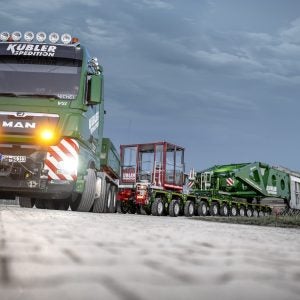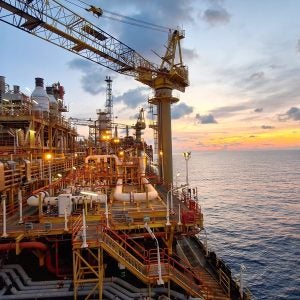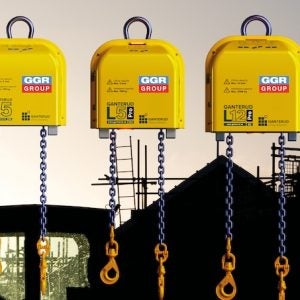Luffing jib cranes were the original tower cranes. In Europe after the Second World War, where transport-friendly construction cranes were developed, the rail-mounted, bottom slewing, luffing jib crane was dominant. The most popular models were built by Liebherr and Peiner.
However, at the end of the 1960s, the basic shape of the so-called French-made top slewing saddle jib crane began to displace the traditional luffers. In the shape of the early Potain, Weitz and later Richier models, the saddle jib concept became a popular construction tool. Other European crane manufacturers followed this trend with the effect that the saddle jib crane’s market share increased from 30% in 1968 to 90% in 1972 in the 80Mpm-plus class.
Top slewing luffing and climbing cranes
In 1958 Liebherr presented the “Universal Crane”, a top slewing luffer with hydraulically operated luffing rams. The HB series from 30tm to 90tm had an extremely short counter radius allowing multiple crane operation on high rise projects.
A similar luffing jib crane concept with luffing rams, but with rope-operated travelling counterweight and diesel hydraulic drive, was introduced in 1964 by Favco. These cranes were heavy luffers with capacities of more than 100tm. Favco’s biggest break came in 1966 with the development of the massive STD 2700, a 45t capacity climbing crane. Eight of these cranes, the forebears of all later large luffing jib climbing cranes, helped to build the World Trade Centre in New York, USA.
Meanwhile IHI introduced so-called pedestal luffing jib tower cranes for its domestic Japanese market. Cranes of 200tm had already been used on the first 35-storey building in Tokyo in 1958. Because of the risk of earthquakes, Japanese tower cranes are manufactured with rigidity in mind. Therefore design features, at least on models above 200tm, include sectional cylindrical towers instead of square lattice type frames and the jib foot is up to 4m wide. To simplify climbing, the tower is raised in the centre of the slewing ring when the crane moves from one storey to the next.
Giants in steel erection and power generation
The energy policy of the 1970s called for very large top slewing luffing jib cranes, some of which were purpose built for specific projects. A real giant was the 3,220tm Krupp luffer, mounted on a 10m by 10m wide tower and able to lift 70t at a 46m radius, and even 40t at a 73m radius. The counterweight is made up of three 18m-high tanks filled with water.
This giant was only surpassed in 1992 by Belleli’s self-built luffing jib monster, equipped with a sort of superlift backmast larger than the main boom. When rigged with 250t of superlift ballast, it could lift 700t at a 20m radius. This crane was engaged in nuclear power station projects in Italy.
Also working in the power industry were the IHI and Mitsubishi 60t-capacity luffing jib tower cranes on cylindrical towers, providing a load moment of 2,400tm. While large 900tm Favco cranes were used in power station projects as roof mounted cranes, an even larger model was planned for a steel mill project in 1984, but it was never actually produced. This 4,200tm giant was supposed to lift 60t at 70m, in four rope fall configuration, and 25t at 95m radius.
Link-Belt meanwhile, in the USA, manufactured climbing tower cranes incorporating Favco design features. The main difference was the machinery cab covering the diesel engine and the hydraulic system. Several units of the large 2300B with a maximum load moment of 1,081tm are still in service with Jake’s Crane, Rigging & Transport International.
In Europe it was again a power station project, the coal-fired Black Pump in Germany, which in 1995 called for giant 1,300tm luffers. The extraordinary feature of this model, the Wolff 60140B, apart from its capacity, is the enormous free-standing height of 90m.
Favelle Favco has just upgraded the M440D, a 440tm luffing jib climbing crane for upcoming projects in New York and the first machine is due for delivery. In single fall operation it will have a maximum lifting capacity of 20t at the main hoist and 8t at the auxiliary hoist. Winch capacity is claimed to allow a maximum hook height of 600m.
European diversification – complex solutions
High rise building projects in booming Asian markets, established air rights licensing systems, and complications when oversailing neighbouring properties combined to drive the development of numerous luffing jib crane designs by nearly every European manufacturer. Complex mechanical solutions were tried to counterbalance the dead load moment of the boom when it luffs.
Traditional rope-shifted counterweight was replaced by massive ballast swings on the Liebherr 500 HC-L in 1985. BKT used much the same system on all models above 75tm but found more transport-friendly lightweight solutions. In 1997 Comedil introduced a mechanical link between the counterweight and jib, slung under the machinery deck of the CTL 400.
An even more complex system was introduced by Potain in 1989. When raising the jib of the MR300, the ballast approaches the crane tower under the force of gravity provided by a moving machinery platform foot. The platform itself tilts under the action of rods operated by the moving jib. In the 1990s cost-intensive individual counterbalance solutions have been abandoned by most European manufacturers. Only Peiner still provides rope-shifted counterweight for all its luffing jib cranes.
The articulated jib crane – a saddle/luffing hybrid
The Maschinenfabrik Otto Kaiser KG, later integrated into the Elba works, developed an unusual crane concept, the Kaiser HBK series, which in the 1960s and 1970s proved very successful. This top slewing climbing tower crane combines the benefits of a standard saddle jib crane and the luffing jib design. The main design criteria are the foldable luffing saddle jib and an extremely short counter radius ranging from 5.8m to 8m in the 50tm to 100tm class.
In trolley boom position the crane works with maximum outreach. When luffing the jib, excess radius is converted into increased height within minutes, without installation of additional tower sections. This design feature is especially useful for the construction of cooling towers, television towers and sky scrapers. Compared with normal luffing jib cranes the advantages are a design-typical horizontal load movement and lower power consumption when working at different radii with the trolley. The main disadvantage is the relatively low capacity at minimum radius with the jib in luffing position.
Kaiser cranes were equipped with tilting turntable frames for tower erection and the use of tower sections of up to 12m was permitted. As well as many tall building projects, like the 331.4m Frankfurt TV tower, large cooling towers were raised with Kaiser HBK cranes. The large base diameter needed the crane’s full outreach. Working radius no longer required at the narrower upper part of the cooling tower was available as extra hook height by articulating the jib. Cooling towers up to 130m high were built without bracing the crane. When climbing down, the whole crane could pass through the conical aperture.
Liebherr and Peiner followed the Kaiser articulated jib crane design. Flagship of the Liebherr range was the 180 HC-K, used on the 150m high Gösgen cooling tower in Switzerland in 1977. Peiner only had one articulated jib crane in its product range, the SKK 140. Impressive free standing heights of 84.4m were achieved by adding M1300 tower sections to the standard SK 160 tower sections.
While some veterans are still working, mainly on cramped city site projects, today’s large cooling towers over 200m high have such large base diameters that even the largest available articulated jib cranes with 60m to 65m jibs in the 150tm to 200tm class cannot cope with the required working radius of the crane rigged in the centre. In this case large saddle jib cranes with special jibs that have folding devices in order to climb down inside the cooling tower are used. The required lifting capacity of today’s high rise construction projects and the dimensions of the new generation of natural draught, wet cooling towers have led to a decline of specific jobs for the universal but expensive articulated jib crane concept. No new models have been developed since 1983.
The extraordinary EMA lifting device
In 1985, during the French nuclear power station construction programme, Potain designed a top slewing climbing crane with a counter radius of only 4.8m and a telescopic saddle jib of 16m to 30m radius. To overcome space problems when slewing next to the reactor dome, the retracted jib could be lifted without extending the height of the crane head. This was made possible by luffing the telescopic saddle jib, fixed to a sort of telescoping frame slide down the upper part of the tower. Thereafter the minimum radius was only 5m. With the jib raised, 2t could be lifted and maximum capacity in the horizontal position was 4t. One of these units was used on a cramped London city site project in 1990.
Luffing jib tower cranes with telescopic booms
Some manufacturers of telescopic boom mobile cranes, especially Americans like Grove and Manitex, found a niche market in mounting upper structures on climbing system towers. The benefit of this concept, used mostly in nuclear power station projects, is the ability to work inside a dome with restricted space above and sideways. The main disadvantage is a typically heavy upper structure which causes high corner forces. There is also a sharp decrease in the load curve with extended jib and the jib length of the telescopic boom is normally restricted to 20m-30m radius.
For a British nuclear power station project in 1989 Liebherr revived the concept in the form of the 100 HC-F. Koshihara Industries of Japan developed a self-climbing mini crane version with a 10.75m, three section, telescopic jib. The lightweight 1.5t capacity KCS-1010 is particularly suitable for small urban projects. The recent lack of nuclear power station projects has lead to a very restricted market, especially for the larger telescopic luffing tower cranes.
The folding jib tower crane – no future?
In the 1970s Krøll designed the K103V and K202V tower cranes, similar in appearance to double lever boom harbour cranes mounted on a conventional tower. The main benefit is not only the constant load height when luffing, but also the ability to work underneath saddle jib umbrella cranes without needing extreme tower height on the oversailing crane. In certain cases this crane is also less sensitive to wind than common single jib luffers. The K103V level luffing jib model has a short 6.5m counterweight radius, equal to the radius of the retracted jib, so it can lift into confined spaces.
At the opposite end of the scale from this 1,344tm crane is another Swedish company, Tornborgs, representing the 46tm class. This lightweight gooseneck crane followed the S-40, first manufactured in the early 1970s. The standard tower fits in most lift shafts and respectable free standing heights are obtained by combining the crane with medium sized towers from major tower crane suppliers. Hence hybrid Tornborgs cranes are a common sight.
BKT tried to revive the Tornborgs concept in 1995 by developing the BM 45. Although this multipurpose crane can work in two modes, as a gooseneck and as a conventional luffer, only a few have gone into service. There appears to be little demand in the 40tm class. Furthermore, the main benefit of larger versions of this design, to keep the load height constant when luffing, can be easily done by sophisticated electronic horizontal hook-path regulation without the relatively expensive mechanical mechanism.
Fixed counterweight versus movable counterweight – a matter of philosophy?
The idea of movable counterweight on a luffing jib crane is appealing, for if the dead load moment of the boom luffs, it can be balanced by a counterweight. Furthermore, lowering the boom against wind forces can be done by moving counterweight.
A third argument is that there is a lower energy requirement to move the jib and corner forces are lower. Some manufacturers only provide cranes with moving counterweight, but most use them only on larger models. However, a growing number prefer fixed counterweight throughout their range.
In 1987 Favco changed its design from moving counterweight to fixed counterweight, citing as reasons: • the counterweight only balances less than 20% of the boom dead load moment • moving counterweight requires more service and inspection • the moving counterweight design is expensive.
It seems that for a long time the divergence of views generated discussion about the preferred counterweight arrangement.
A trend towards compact design
Luffing jib cranes are mainly used on sites which are narrow, where space is scarce. Today’s city construction sites, as well as industrial sites like power station renovations, call for crane systems with minimal counterweight radius. For that reason the traditional longer counter jibs of older models have been replaced by short versions. This trend is well illustrated by the Tornborgs S-46 (4.6m counter radius) following the S-40 (7.6m counter radius). The Wolff 320B, developed in 1988, has design features similar to the dimensions of the Kodiak KL-130L, built in the 1970s, with 10.6m counter radius. For the Wolff 320 BE-G7 the counter radius was reduced from 10.3m to 7.2m. Furthermore, wide machinery decks are becoming more and more unpopular as they need larger tie-in devices to climb down beside tall buildings.
Because large side mounted cabs can be an obstacle, Favco introduced the left or right hand interchangeable cabin. Wolff solved this problem on the 60140B version with the option to integrate the cabin into the A-frame during the climbing down procedure. Again, major consideration is given to the transport dimensions of the components. For example jib sections of modern luffers can be transported inside tower sections.
Particularly in Europe, emphasis is placed on the difference between free-standing tower heights of saddle jib and luffing cranes. Therefore the former boundary of about 40m is surpassed, as is demonstrated by the Wolff 60140B which has a respectable free-standing height of 90m on compact 3.3m by 3.3m tower sections.
Purpose-built small luffing jib climbing cranes can climb down under most cramped site conditions, such as the erection of ultra-high pylons. A good example is the Hitachi CT 45 bottom climbing, top slewing luffer with a maximum radius of 21m and a maximum capacity of 4t at 12m radius. This special mini luffing jib tower crane was developed in the 1980s.
In 1998 BKT devised the MR 35 for the same sort of application, to build 150m high power transmission towers and to climb down inside the pylons with 90O boom angle.






